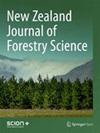Comparison of the biology, ecology and potential pest impacts of the eucalypt-defoliating leaf beetles Paropsisterna cloelia and Paropsis charybdis (Coleoptera: Chrysomelidae) in New Zealand
IF 1.5
4区 农林科学
Q2 FORESTRY
引用次数: 0
Abstract
Background: Eucalypt species are grown in New Zealand for a variety of purposes. Paropsine leaf beetles (Coleoptera: Chrysomelidae) impact eucalypt plantations in Australia and other countries where eucalypts have become established. Six eucalypt-feeding paropsines from Australia have established in New Zealand to date. Paropsis charybdis Stål is currently regarded as the worst eucalypt pest. Paropsisterna cloelia (Stål) established in New Zealand in 2016 and it remains uncertain whether its potential impacts will exceed those caused by P. charybdis. Methods: In this review, we provide an update on eucalypt insect invasions in New Zealand, summarise available literature on Pst. cloelia, and compare its ecology to P. charybdis, including distribution, host preferences, phenology, and natural enemies. Finally, we identify key areas for future research and give recommendations for integrated pest management. Results: The number of specialist eucalypt-feeding insects has increased to approx. 36 species. The largely overlapping distributions of P. charybdis and Pst. cloelia in Australia indicate a similar climate tolerance; hence Pst. cloelia is likely to spread throughout New Zealand over time. Life history traits and behaviour of Pst. cloelia suggest it has a higher reproductive output and higher survival rate of immature stages than P. charybdis. This could potentially lead to severe defoliation from more frequent population outbreaks of Pst. cloelia, particularly under climatic conditions that induce growth stress in trees. Both species seem to prefer eucalypt species from different sections within the subgenus Symphyomyrtus, indicating a degree of niche separation. Paropsisterna cloelia larvae feed on both flush juvenile and adult leaves of heteroblastic eucalypt species (i.e., producing morphologically different juvenile and adult leaves), which would be of particular concern if it were to invade E. nitens plantations. Conclusions: We believe that Pst. cloelia has the potential to exceed the observed impacts from P. charybdis in New Zealand and cause growth losses in its most preferred eucalypt species. An integrated pest management approach that employs strategies, such as breeding for resistance, choice and siting of species, biological control, and/or pesticide use at set damage thresholds could result in significant economic benefits and resilience. As biocontrol is a long-term solution, other strategies need to be investigated and implemented without delay for the industry to be pre-emptive.新西兰桉树落叶甲虫 Paropsisterna cloelia 和 Paropsis charybdis(鞘翅目:蝶形目)的生物学、生态学和潜在虫害影响比较
背景:新西兰种植桉树的目的多种多样。副栉叶甲虫(鞘翅目:蝶形目)对澳大利亚和其他种植桉树的国家的桉树种植园造成了影响。迄今为止,已有六种来自澳大利亚、以桉树为食的副叶甲虫在新西兰定居。Paropsis charybdis Stål 目前被认为是最严重的桉树害虫。Paropsisterna cloelia(Stål)于2016年在新西兰立足,目前仍不确定其潜在影响是否会超过P. charybdis造成的影响:在这篇综述中,我们提供了新西兰桉树昆虫入侵的最新情况,总结了关于 Pst. cloelia 的现有文献,并将其生态学与 P. charybdis 进行了比较,包括分布、寄主偏好、物候学和天敌。最后,我们确定了未来研究的关键领域,并提出了虫害综合防治建议:结果:专门以桉树为食的昆虫数量已增至约 36 种。P. charybdis 和 Pst. cloelia 在澳大利亚的分布大体重叠,这表明它们对气候的耐受性相似;因此,随着时间的推移,Pst.Pst. cloelia 的生活史特征和行为表明,与 P. charybdis 相比,它的繁殖能力更强,未成熟阶段的存活率更高。这可能会导致 Pst. cloelia 种群更频繁地爆发而造成严重落叶,尤其是在会引起树木生长压力的气候条件下。这两个物种似乎都喜欢亚属 Symphyomyrtus 中不同部分的桉树物种,这表明存在一定程度的生态位分离。Paropsisterna cloelia幼虫以异形桉树物种的齐平幼叶和成叶(即产生形态不同的幼叶和成叶)为食,如果它入侵 E. nitens种植园,这将是一个特别值得关注的问题:我们认为,Pst.cloelia 有可能超过 P. charybdis 在新西兰造成的影响,并导致其最喜欢的桉树品种生长受阻。害虫综合治理方法可带来显著的经济效益和恢复能力,该方法采用的策略包括抗性培育、物种选择和选址、生物防治和/或在设定的损害阈值下使用杀虫剂。由于生物防治是一个长期解决方案,因此需要立即调查和实施其他战略,以便该行业先发制人。
本文章由计算机程序翻译,如有差异,请以英文原文为准。
求助全文
约1分钟内获得全文
求助全文
来源期刊

New Zealand Journal of Forestry Science
FORESTRY-
CiteScore
2.20
自引率
13.30%
发文量
20
审稿时长
39 weeks
期刊介绍:
The New Zealand Journal of Forestry Science is an international journal covering the breadth of forestry science. Planted forests are a particular focus but manuscripts on a wide range of forestry topics will also be considered. The journal''s scope covers forestry species, which are those capable of reaching at least five metres in height at maturity in the place they are located, but not grown or managed primarily for fruit or nut production.
文献相关原料
| 公司名称 | 产品信息 | 采购帮参考价格 |
|---|
 求助内容:
求助内容: 应助结果提醒方式:
应助结果提醒方式:


